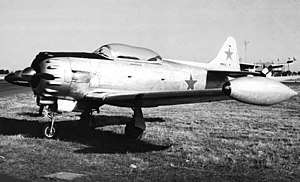Bacon Super T-6
The Bacon Super T-6 was a North American AT-6F Texan that was modified during the mid 1950s by the Erle L. Bacon Corporation in an attempt to interest foreign air forces in an upgrade for their T-6 fleets. The aircraft did not receive sufficient interest for production, and only the single conversion was produced.
| Super T-6 | |
|---|---|
 | |
| The Super T-6 | |
| Role | Trainer aircraft |
| National origin | United States |
| Manufacturer | Erle L. Bacon Corporation |
| First flight | April 1957 |
| Number built | 1 |
| Developed from | North American T-6 Texan |
History
Produced in 1944 and operated by the United States Army Air Forces alongside its brethren, following the end of World War II AT-6F Texan 44-82028 was sold on the civilian market, operating in Iceland for a time before being acquired by Bacon for conversion. Described as appearing "like an illicit hangar affair between a T-33 and a T-6",[1] the conversion consisted of adding the canopy, tip tanks, and tricycle landing gear from a Lockheed T-33 Shooting Star;[1] streamlining of the cowl and wings including jet stack exhaust, augmenter cooling, and a 4-foot (1.2 m) reduction in wingspan compared to the standard T-6; in addition, the cockpit was upgraded with a revised instrument panel and modernized avionics, and the aircraft's brakes were upgraded.[2]
Bacon hoped to sell the conversion to foreign air forces, many of which operated large fleets of T-6 aircraft;[2] after taxi trials at the end of 1956, it first flew in April 1957, and flight testing was considered generally successful.[2] No interest from its intended customers materialized and the aircraft was sold on the civilian market; it eventually received a paint scheme, believed to have been intended for a role in a movie, resembling that of a Russian fighter aircraft.[1] It was stored at Whiteman Air Park in California, and allowed to deteriorate in the elements, with its registration being cancelled in 2013.[3][4]
Specifications
Data from Jane's All The World's Aircraft 1958–59[2]
General characteristics
- Crew: 2
- Length: 29 ft 6 in (8.99 m)
- Wingspan: 38 ft 6 in (11.73 m)
- Height: 11 ft 8.5 in (3.569 m)
- Fuel capacity: 100 US gal (83 imp gal; 379 l) in two tip tanks
- Powerplant: 1 × Pratt & Whitney R-1340-AN-1 Wasp 9-cylinder air-cooled radial piston engine, 600 hp (450 kW)
- Propellers: 2-bladed variable-pitch propeller
Performance
- Maximum speed: 225 mph (362 km/h, 196 kn)
- Cruise speed: 215 mph (346 km/h, 187 kn) at 64% power
- Rate of climb: 1,750 ft/min (8.9 m/s) at sea level
Armament
- .30-inch (7.6 mm) machine guns, underwing bomb racks or rocket launchers optional
See also
Related development
- North American NA-16
- North American BT-9
- North American T-6 Texan
- North American A-27
- North American P-64
- CAC Wirraway
Aircraft of comparable role, configuration and era
Related lists
References
- Hagedorn, Dan (2009). North American's T-6: A Definitive History of the World's Most Famous Trainer. North Branch, MN: Specialty Press. p. 169. ISBN 978-1-58007-124-6.
- Bridgman, Leonard, ed. (1958). Jane's All the World's Aircraft 1958-59. London: Jane's All the World's Aircraft Publishing Co. Ltd. p. 253.
- "1944 USAAF Serial Numbers (44-70255 to 44-83885)". USASC-USAAS-USAAC-USAAF-USAF Military Aircraft Serial Numbers. Joe Baugher. 17 October 2017. Retrieved 2017-12-01.
- "N-Number Inquiry Results: N66J". FAA Registry. Federal Aviation Administration. Retrieved 2017-12-01.